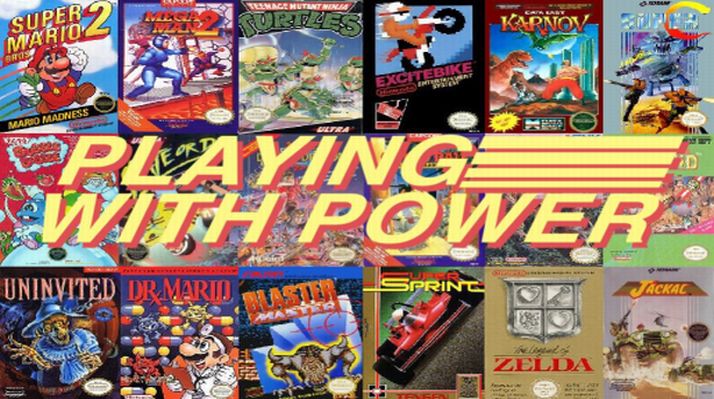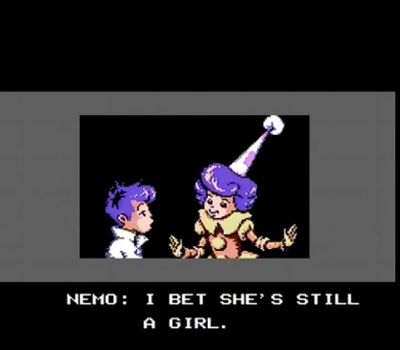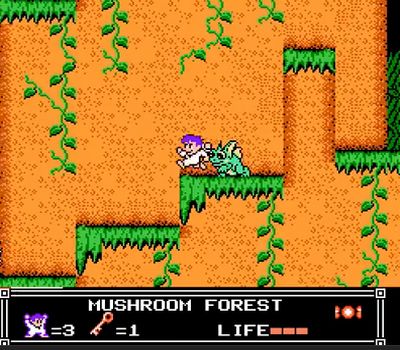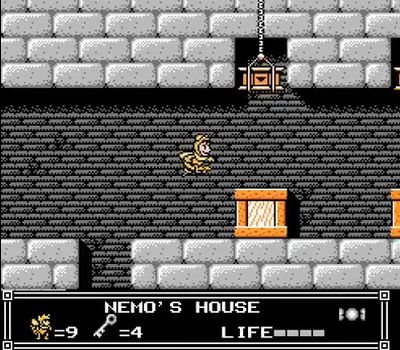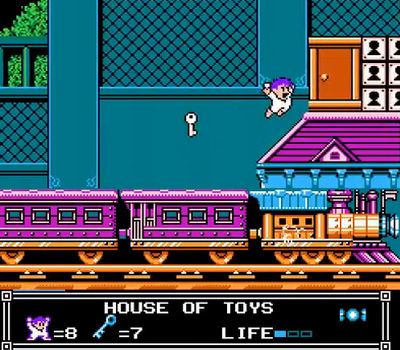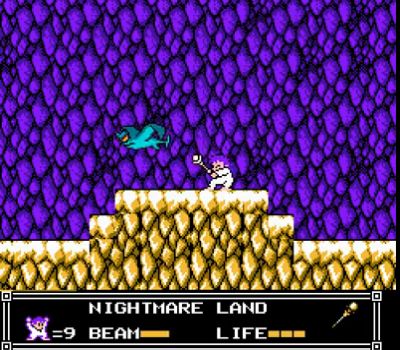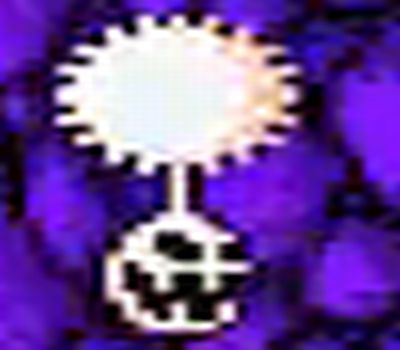Welcome to another edition of Playing With Power. The review article that looks at all things Nintendo Entertainment System. To sleep, perchance to dream. To play, perchance to win. To review, perchance to entertain. And to adapt an early 1900’s comic strip into a video game perchance to make an instant classic. That definitely could be the case with this week’s game. Capcom adapting a video game from a movie based on a classic comic strip? could this be a dream come true? Or a living nightmare? Let’s find out as we get some shut eye and travel into the world of “Little Nemo: The Dream Master”.
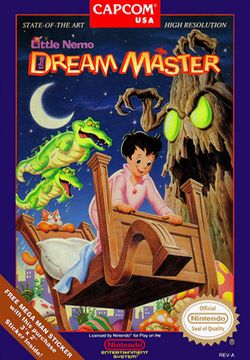 YEAR OF RELEASE: 1990
YEAR OF RELEASE: 1990
PUBLISHER: Capcom
GENRE: Action Platformer
Little Nemo is a franchise with a long history behind it. It started as a comic strip by Windsor McKay all the way back in 1905. The comics were about the adventures of a young boy named Nemo in the world of Slumberland, a land Nemo inhabits whenever he sleeps. The strip was very trippy, and surreal, especially for its time.
The popularity of the strip would be enough for the Japanese studio Tokyo Movie Shinsha to adapt it into a fully animated film. The movie was simply called Nemo in Japan and was released in 1989. To coincide with the release of the film, Capcom would work on a video game adaptation.
In September of 1990, a year after the film’s release in Japan, Little Nemo: The Dream Master would be released in North America. But there was one interesting snag to the US release, and that was the fact that the movie had not been released outside of Japan. In fact, it would take two more years to see the film’s US release, now under the name “Little Nemo: Adventures in Slumberland”. Despite the confusion, the game still turned out a decent seller on the NES, and has gone to become a cult classic among retro gamers. But do these claims of cult classic quality really hold true? Let’s delve deeper.
COVER STORY
I love this cover. Lots of things going on, great artwork, and of course, as I’ve often stated, that beautiful purple Capcom border. Nemo is well drawn, and I really love just how weird things look, from the creepy tree, to the flying alligators. I think most people were likely drawn to the cool cover, or at least the Mega Man sticker inside. It definitely seems that the interest certainly wasn’t due to the history of Little Nemo, which I think by the early 90’s wasn’t exactly the most memorable franchises to most. It’s certainly one of Capcom’s best.
STORY
It’s the year 1905 in New York, and a young boy named Nemo is sleeping in his bed. However, all of a sudden a giant blimp appears outside his window. A messenger enters his room to give Nemo an invitation to Slumberland to play with Camille, princess of Slumberland. Nemo is at first hesitant to go, since to him, girls are yucky.
However, despite the fear of cooties, Nemo is coaxed to Slumberland by the true way to a kid’s heart, which is of course an unlimited supply of candy. Now with a very sweet incentive in mind, Nemo heads off to the land of slumber. What adventures will Nemo have, and what dangers lay in wait?
GAMEPLAY
Little Nemo: The Dream Master is a one player action platformer. You control Nemo as you must travel through each level of the world of Slumberland. You move Nemo with the D-Pad, jump with the A button, and shoot candy with the B button. Nemo starts the game with 3 lives, and has a hit meter of three hits.
The object of each level of the game is to find the many keys scattered through each stage, often around six to eight. All of these keys are needed to open the door at the end of the level. But they aren’t always that easy to find. Some can be high in the air, way too high for Nemo to jump. They can be underground, or underwater. And you must find all of them, or the door will not open, and you can’t advance.
Now, Nemo himself is powerless to find most keys, and with only candy as his main arsenal, he can’t attack enemies either. Instead, he must rely on the help of his animal friends to give him the tools needed to find keys or defeat foes. To do so, you must find the right animal and feed it at least 3 pieces of candy. This will put the animal in a sleep state, giving you a perfect chance to ride it. if you try to ride them before they go to sleep, you will take damage. You’ll know which animal is the ridable one because they won’t attack Nemo directly.
These animals include a spiky frog that can jump high, a gorilla that can attack and climb trees, a bee that can fly for a short period of time, a mole that can dig through dirt, and more. You can ride them for as long as you like (pressing select will stop), or until you die by taking too much damage. Each animal has their own health bar, which has more or less health depending on the creature. The gorilla for example has the most, while creatures like the frog have a very limited health amount. Not all animal friends will be able to attack enemies (the purple lizard for example), so knowing what animal to use in a certain situation is vital to success.
But thankfully Nemo does get some help besides the animal buddies. Each level is filled with health bottles that fill one point of health, or first aid kits that can give him full health again. Plus, there are a decent amount of extra lives as well. And trust me, this game is one that you’ll need every single live you can find.
The game is broken into eight levels. You’ll start at a mushroom forest, then to a giant flower garden. You’ll enter a giant toy room, where you’ll have to survive on a giant toy train as it passes through some crazy obstacles. You’ll enter a topsy turvy version of Nemo’s house, and even have to traverse through the sky. Each of these levels ends with a door to open.
But then the game decides to suddenly give the player a massive game changer come the last level of the game. When Nemo finally meets Princess Camille, she tells him that the evil King of Nightmares has captured her father King Morpheus. So now Nemo is given a weapon in the morning star, and must battle through the toughest set of platforming and enemies in the game.
The morning star is used with the B button. With a tap of the button, it’s a basic strike attack, but when you hold the button down, you can charge up a powerful shot, not unlike Mega Man’s mega buster. You can also still use candy and get animal friends to help you. The final level is large, broken into several stages, and each has a boss at the end, so no more dealing with finding keys.
The biggest downside though is should you get game over (and trust me, you WILL get game over), you’ll have to start all the way back at the beginning of the Nightmare Land level.Thankfully the game is kind enough to offer an unlimited supply of continues, so you will have multiple opportunities to get back to where you were. Just get ready to die… a lot!
The game also has a ton of weird and challenging enemies. Each of them a pain in the butt. You have weird bees that dive bomb at you. There are giant worms, snails that have spiky shells, monkeys that throw an unlimited supply of dishes at you. And even flying turtles that spit out turtle shells. All very weird, but add to the nonsensical dreamworld motif of the game.
And then there’s these jerks. These evil floating pieces of dandelion fluff will be the cause of your frustration throughout most of the game. The problem is not so much that they’re pattern is annoying. In fact, for most areas, they can be avoided. The problem is they almost never stop dropping. And when climbing up an area, it can really curtail your momentum, or cause a quick death.
Other than that, the game controls quite well, with really no hit detection worth noting, except for when you have to break blocks using the hammer you get while riding the mouse. Nemo himself has a decent jump, and he moves at an okay speed. The only thing that will be a bother to some is the sometimes seemingly unfair difficulty. It’s Capcom at their unruly best. It’s not Ghosts and Goblins hard, but it will still give you quite the run for your money.
Little Nemo doesn’t have a password or save function to the game, however Capcom was still very generous to put a level select code in the game. Or, you could say in this case a dream select. At the title screen, press Up, Select, Left, Right, A, A, B. Highlight the newly opened option and press A the number of times needed to get to the level of your choosing.
GRAPHICS
Capcom outdid themselves with this game. It’s easily one of the best looking games on the NES. Levels are colorful and lush, using the limits of the NES palette to perfection. The game also has plenty of cut scenes, which are all well detailed, and really give the game a nice touch. Not to mention characters look almost exactly like their animated counterparts. Nemo, Princess Camille, and even that green guy Flip are all really well detailed, and look great in 8-bit. Enemies are also well detailed, and have lots of personality to them despite the limitations of the NES.
Even the minor things like Nemo jumping into bed before the level begins, or Nemo either in or out of bed at the end of the level (while being yelled at by his parents) all adds just a little more flavor to this game. Classic Capcom rarely disappoints, and this is another example of why.
MUSIC
Speaking of classic Capcom rarely disappointing, this is an epic soundtrack. Every level gives off a very vibrant tune, each with a feeling of a big adventure that awaits our hero. I honestly don’t think any song in the game is bad. Everything from the title screen, the levels themselves, and the stage end theme each are very well done.
It’s probably one of the most overlooked soundtracks on the NES, especially from the Capcom library, as Mega Man and some of the Disney games often get the most attention. This one is certainly deserving of just as much love as say, Mega Man 2 or Ducktales.
TUNE OF THE GAME
Now it’s time to introduce another new section to Playing With Power. This being the tune of the game, where the best song of the game (at least in my opinion) is given the spotlight for you the reader to enjoy some 8-bit excellence. For Little Nemo, it’s a hard choice to pick just one great song on the soundtrack. But when it was all said and done, the clear cut choice was the ending song.
This game has some epic tunes, especially the first few levels, but this ending song is just very moving for some reason. For as brief as the tune is, it really gives off the feeling that this big adventure, and all the fun and excitement you’ve had along the way is coming to a happy, yet still somewhat melancholy ending.
For some reason as well, it also gives a sense of bittersweet nostalgia, that makes you think of the worlds you’ve been to, and the friends you’ve made along the way. And that’s something that just really sticks with me after beating this game. Call it a case of overlooking things as I always do, but to me it’s honestly a feeling I miss in gaming, and it was great to feel it again with this ending tune. My clear cut choice for best tune of game. Enjoy.
OVERALL THOUGHTS
Little Nemo: The Dream Master is a fun, yet challenging game. Great graphics, sound, and control all are included in this bundle, not to mention some innovative for its time gameplay ideas like being able to use the different animals to help you out. It’s also one of those licensed games you can enjoy even if you’re not too well versed in the franchise the game was based off of, or even the movie this was directly based off of.
I’d say the only turn off for some will be the often unforgiving difficulty, but if you can get through that and stick with it, you are getting one of the best adventures on the NES. If you can find this one, don’t just dream about it, give it a play.
RATING: Thumbs Up

